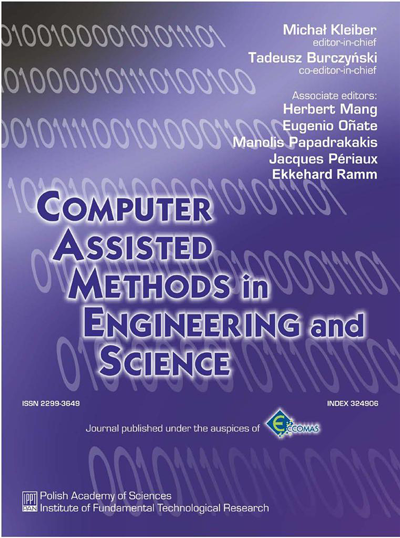Application of swarm intelligence algorithms in solving the inverse heat conduction problem
Abstract
In the paper a proposal of using selected swarm intelligence algorithms for solving the inverse heat conduction problem is presented. The analyzed problem consists in reconstructing temperature distribution in the given domain and the form of heat transfer coefficient appearing in the boundary condition of the third kind. The investigated approaches are based on the Artificial Bee Colony algorithm and the Ant Colony Optimization algorithm, the efficiency of which are examined and compared.
Keywords
Swarm Intelligence, ACO algorithm, ABC algorithm, Inverse Heat Conduction Problem,References
[1] J.V. Beck, B. Blackwell, C.R. St.Clair. Inverse Heat Conduction: Ill Posed Problems, Wiley Intersc., New York, 1985.[2] J.V. Beck, K.D. Cole, A. Haji-Sheikh, B. Litkouhi. Heat Conduction Using Green’s Functions. Hempisphere, Publishing Corporation, Philadelphia, 1992.
[3] M. Dorigo, T. Stutzle. Ant Colony Optimization. MIT Press, 2004.
[4] M. Duran Toksari. Ant Colony Optimization for finding the global minimum. Applied Mathematics and Computation, 176: 308–316, 2006.
[5] R. Grzymkowski, D. Słota. Numerical calculations of the heat-transfer coefficient during solidification of alloys. Moving boundaries VI. Computational modelling of free and moving boundary problems. B. Sarler, C.A. Brebbia, eds., WIT Press, Southampton: 41–50, 2001.
[6] A. Haji-Sheikh, F.P. Buckingham. Multidimensional inverse heat conduction using the Monte Carlo method. Trans. of ASME. Journal of Heat Transfer, 115: 26–33, 1993.
[7] E. Hetmaniok, D. Słota, A. Zielonka. Solution of the inverse heat conduction problem by using the ABC algorithm. Lecture Notes in Computer Science, 6086: 659–668, 2010.
[8] E. Hetmaniok, A. Zielonka. Solving the inverse heat conduction problem by using the ant colony optimization algorithm. CMM-2009, University of Zielona Góra Press, 205–206, 2009.
[9] D. Karaboga, B. Akay. A comparative study of artificial bee colony algorithm. Applied Mathematics and Computation, 214: 108–132, 2009.
[10] D. Karaboga, B. Basturk. On the performance of artificial bee colony (ABC) algorithm. Applied Soft Computing, 8: 687–697, 2007.
[11] K. Kurpisz, A.J. Nowak. Numerical analysis of inverse heat conduction problems with Boundary Elements Method and combined techniques. ZAMM Z. Angew. Math. Mech., Annual GAMM Conference: 301–308, 1993.
[12] D.A. Mourio. The Mollification Method and the Numerical Solution of Ill-posed Problems. John Wiley and Sons Inc., New York, 1993.
[13] A.J. Nowak. BEM approach to inverse thermal problems. In: D.B. Ingham, L.C. Wrobel, eds., Boundary integral formulations for inverse analysis, chapter 10, 259-298. Comp. Mech. Publications, Advances in Boundary Elements Series, 1997.
[14] Z. Ostrowski, R.A. Białecki, A.J. Kassab. Solving inverse heat conduction problems using trained POD-RBF network inverse method. Inverse Problems in Science and Engineering, 16: 39–54, 2008.
[15] A. Ryfa, R. Białecki. The heat transfer coefficient spatial distribution reconstruction by an inverse technique. Inverse Problems in Science and Engineering, 19: 117–126, 2011.
[16] D. Słota. Solving the inverse Stefan design problem using genetic algorithm. Inverse Problems in Science and Engineering, 16: 829–846, 2008.
[17] D. Słota. Restoring boundary conditions in the solidification of pure metals. Compututers & Structures, 89: 48–54, 2011.
[18] C.Y. Qiu, C.L. Fu, Y.B. Zhu. Wavelets and regularization of the sideways heat equation. Computers and Mathematics with Applications, 46: 821–829, 2003.
Published
Jan 25, 2017
How to Cite
HETMANIOK, Edyta; SŁOTA, Damian; ZIELONKA, Adam.
Application of swarm intelligence algorithms in solving the inverse heat conduction problem.
Computer Assisted Methods in Engineering and Science, [S.l.], v. 19, n. 4, p. 361-367, jan. 2017.
ISSN 2956-5839.
Available at: <https://cames.ippt.gov.pl/index.php/cames/article/view/86>. Date accessed: 06 may 2025.
doi: http://dx.doi.org/10.24423/cames.86.
Issue
Section
Articles




